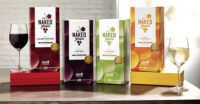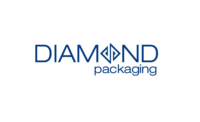Wine Packaging Takes the Grape


The wine industry, so rich in heritage, has long been known for its conservative approach to packaging. But thanks to the continued proliferation of wine brands, that is changing, particularly in
Boisset Family Estates, with wineries in Europe and the
Boisset also chose PET bottles for its Yellow Jersey wines; for Louis Bernard Bonus Passus, an AOC (Appellation d’Origine Controlee) Côte du Rhône; for Fog Mountain California Nouveau wine; and, most recently, announced that all of the Beaujolais Nouveau wines it imports into
This summer, Boisset took the lead on another packaging innovation, filling its Mommessin Beaujolais Grande Reserve Red 2007 into an aluminum bottle with a screw cap. The marketing goal was to get Americans to enjoy
The Mommessin package provides the education, with a hang tag that addresses temperature and directs consumers to monitor the thermochromic dot on the label. When the wine has been chilled to the appropriate serving temperature, the dot changes from white to blue.
The idea was to “not only attract new consumers but at the same time convey that the wine should be served chilled,” says Jean-Charles Boisset, the company’s president.
Boisset says he also wanted “a package that would chill faster and stay chilled longer. So we looked around the winery and saw those beautiful stainless steel vats.” The possibilities of a metal container “became so obvious.” In fact, the aluminum bottle cools three to four times faster than glass.
The company, which is environmentally conscious, also wanted the
LABEL INNOVATIONS
Non-traditional decorating and printing techniques are another avenue brand owners are using to distinguish their wines. For its 2007 Oceana Estates Riesling, Boisset silk screens cobalt-blue glass bottles using 22-karat gold “ink.” The image of a mermaid, and a cork-and-capsule finish, complete the elegant presentation.
Even label substrates and printing are changing to better meet the needs of today’s wine brands. For instance, plastic film labels, which stand up well to moisture, are becoming popular for wines that require chilling.
Kris Moe, a wine maker and professional golfer who recently introduced Nineteenth Hole wines, chose such a film label for his Sauvignon Blanc.
Kris Moe Wines are sold in the restaurants of high-end golf courses, which typically chill white wines table-side, in an ice bucket. But, unlike paper substrates, the plastic film maintains its integrity even after hours of being submerged in icy water and sustains brand communication throughout the product’s life cycle.
The Nineteenth Hole line-up also includes Petite Sirah, Port, Pinot Noir and Cabernet Sauvignon varieities. But because these wines do not require an ice bucket, they are decorated with paper labels. Moe plans to add yet another red wine to the portfolio next year, a Tempranillo-Malbec blend.
All Nineteenth Hole labels-both paper and film-are digitally printed, which delivers distinct benefits for the brand. Most importantly, digital printing makes high-quality labels affordable for a small wine maker like Moe, who can’t cost justify high-volume techniques like flexography.
“As wineries get more competitive with each other, they want high-quality, high-resolution labels with high-end graphics. They want that professional look,” says Peter Schambs, product and sales manager at Digitalabel LLC, which prints the Nineteenth Hole labels. Ryan Kaz Design created the brand’s label graphics.
Moe agrees that a premium presentation for his brand is essential. In addition to digitally printed labels, he chose high-quality bottles and corks for his wines, which have on-premise prices of $30 to $40 per bottle. Nineteenth Hole wines “are put in front of very wealthy people with a high level of sophistication and expectation,” he says. “People at that level want high-quality everything.”
In addition to quality, the quick turnaround and short-run capabilities of digital printing are well suited to Moe’s needs. Switching over between print jobs for the various Nineteenth Hole labels is fast and easy because the printing technology is completely electronic, from graphic design to finished labels.
A BRAND REMINDER
Wineries also are looking at labels’ structural design to gain a branding advantage. A deceptively simple innovation that lets the consumer peel off a portion of the wine’s back label puts brand information literally in the hands of consumers.
Called the Wine Find label, from Australia-based Collotype Labels, the innovation consists of a perforated label section that’s not glued to the bottle. A lift-off tab makes it easy to peel off the perforated panel.
The panel can be printed with whatever text and graphics the winery chooses, such as the brand, type of wine, vintage, brand graphics and brand owner’s contact information.
According to Collotype, more than 50 percent of wine consumption involves a wine that’s new to the consumer. In those cases, no matter how much the consumer enjoys the wine and hopes to buy a bottle at retail or order a glass another time, it can be difficult to remember exactly what the wine was. The peel-off panel solves the problem.
Constellation Wines U.S. began using the Wine Find label on all five varieties of Toasted Head wine when it executed a package refresh for the brand last year.
The iconic image of a fire-breathing bear is used for the labels of all five Toasted Head wines, but the background color is yellow for the white wines and red for the reds. The same color convention is used on the peel-away panel as a visual cue for repurchase.
“We put an image of the front label on the Wine Find label so consumers know exactly what they are looking for the next time they go to the store to get it. If we put something different on there, the recognition wouldn’t be as immediate,” says Diana Pawlik, director-channel marketing, Constellation Wines U.S. “That bear breathing fire is what they see on the shelf when they are whizzing by with their shopping cart.”
The Toasted Head peel-away panel also includes the brand’s web site. “If they are looking for additional information, or they are enthusiasts about the brand, it’s another way of directing that energy or enthusiasm back to the brand,” Pawlik says. “The more that we can communicate and migrate the image and awareness of the brand, the better. And what better mechanism than something that comes with and on the package and can be passed along?”
She says on-premise employees like the peel-away panel, too, because it makes their job easier. Instead of soaking off a label or writing down the information for customers, the server or bartender simply tears off the panel and hands it over.
Constellation uses pressure-sensitive peel-away labels for Toasted Head, but the innovation also can be used for wet-glued labels. Outside the
GLASS IN PLACE OF CORK
Closures are also evolving in wine packaging as wineries rethink the classic cork-finish bottle. Synthetic corks and screw caps are becoming acceptable for a wider variety of wines, including some in the premium category. A lesser known alternative to cork is a glass stopper, used in
Closure Systems International (CSI) sells the stopper as the “Vino-Lok System” in Europe, but offers it as the “Vino-Seal System” in the
The Vino-Seal glass stopper incorporates an inert plastic O-ring that provides a buffer between the bottle’s neck finish and the closure. A standard-size tin or polylam capsule is applied over the stopper. The closure system provides a sterile seal that prevents contamination and oxidation.
A special neck finish is required on the bottle, to accommodate the stopper. Vitro Packaging Inc. makes the bottles, and Encore Glass distributes them.
The glass stoppers eliminate cork taint, offer a premium presentation and, in taste tests, have performed as well as corks. A stopper crafted from plastic rather than glass will eventually find its way onto mass-market wines. But for now,
Whitehall Lane Winery started bottling its reserve wines with the stopper about three years ago and has been conducting taste tests since then. “Right from the first, we bottled a few cases of cork-finish in the same bottles, just enough so we could taste” the cork-finish against the glass-stopper wines, says Dean Sylvester,
Referring to the first wine on which he used the glass stopper-Whitehall Lane 2003 Reserve Cabernet Sauvignon-Sylvester says, “We’ve tasted that two or three times now and blind tasted it with the cork versus the Vino-Seal, and so far none of us can tell the difference between the two.” That wine will peak seven to 10 years after bottling, but for now, “so far, so good.”
“It definitely has the presentation appeal, or ceremony, that wine drinkers expect,” says Phil King, national account manager for wine and spirits at CSI. When a Vino-Seal bottle is opened at a restaurant, he says, “You end up having a crowd of people gathered around, and they are all ooh-ing and ah-ing over it.” BP
Looking for a reprint of this article?
From high-res PDFs to custom plaques, order your copy today!








